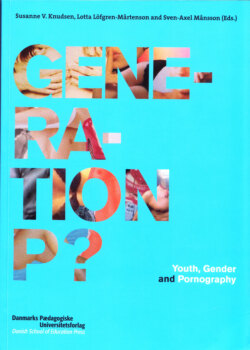Читать книгу Generation P? - Группа авторов - Страница 26
На сайте Литреса книга снята с продажи.
Backlash or experimentation
ОглавлениеIn the feminist academic debate there are two main trends of interpretation of sexualisation and the sexualized representations of postfeminism4: the perspective called backlash and a perspective I propose to call experimentation.
Sexualisation as well as postfeminist sexualized representations in popular culture has been perceived as depoliticized, anti-feminist backlash, that emphasizes individual lifestyle choices and personal desires that are catered to by the media as part of commercial culture. The perspective of backlash regards mainstream sexualisation and the sexualized postfeminist representations as a pronounced expression of the popular culture and as society’s response to and at the same time it’s dismantling of feminism (McRobbie 2004, Braithwaite 2004, Macdonald 1995, Dow 1996). Angela McRobbie, for instance, argues that the effects of the sexualized popular culture undermine the feminist project in the cultural and political context of Great Britain:
We are witness to a hyper-culture of commercial sexuality, one aspect of which is the repudiation of a feminism invoked only to be summarily dismissed. (McRobbie 2004, 259).
Formulated to-the-point, this criticism implies that we are currently witnessing media-based and economic tendencies of integration which promote diversity and forms of denaturalization of gender and sexuality in the shape of individualized lifestyles. Individualization and de-traditionalization are, however, not necessarily antagonistic to conservative norms and neo-liberal processes of change (Engel 2002, 194).
The second main trend in feminist academic debate – the perspective of experimentation – investigates aesthetic and feminist potentials in the sexualized representations in mainstream culture. There are feminist critics that regard postfeminism as a corrective to the devaluation of the feminized, the personal and the intimate in media and culture (Brunsdon 1993, Holloows 2000, Baumgardner & Richards 2000). Critics also claim that some of the representations of sexualized postfeminism manage to destabilize binary categories of gender and sexuality (Braithwaite 2002, Lotz 2001, Brooks 1997). Representations of the sexualized body do not necessarily stage women as passive objects but can also depict them as independent and active sexual subjects as Rosalind Gill claims (Gill 2003). The notion of active consumption (Fiske 1989) opens possibilities for empowerment by using bodies as political sites or tools within the parameters of a capitalist economy, re-signifying the systems of sexual and economic signification (Genz 2006). The binary between culture/pleasure and politics/criticism that is discernible in the feminist debate is basic in the discussion of the meanings of mainstream sexualisation.
If we examine the reviews and public debate with regard to the Norwegian new-feminist anthology titled Rosa Prosa. Om jenter og kåthet (Roggen & Tornes (Eds)(2006), we will see several of the arguments mentioned above. In the second part of this chapter, I will therefore focus on the reception of this publication as an illustration of both mainstream sexualisation and sexualized postfeminist representations and as an example of how the debate about sexualisation is handled in a Norwegian context. The premise for the majority of those who are critical of mainstream sexualisation is that it represents a considerable backlash against feminism. However, I want to argue that in a Norwegian/Scandinavian context, it is difficult to assert the existence of a substantial dismantling of the discourses of feminism in culture or politics. Even so, backlash dominates the Scandinavian feminist academic debate while the perspective of experimentation is nearly absent.5
